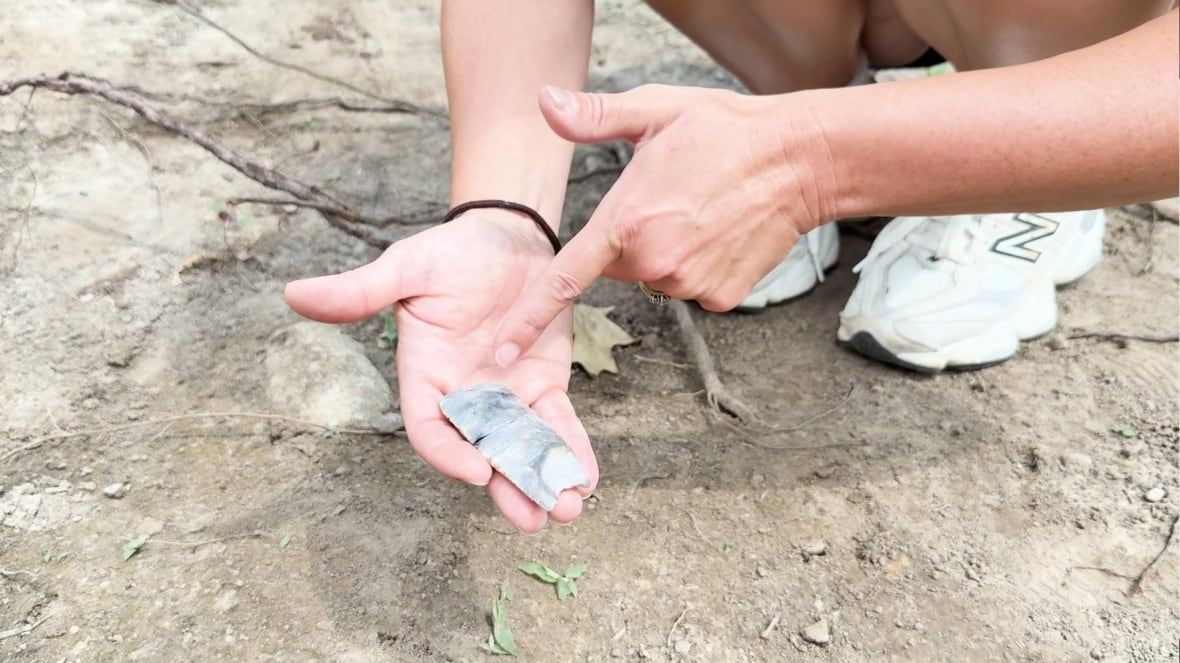Family unearths ancient spearhead at their Paris, Ont., farm in 'freak' discovery

The two pieces were buried under the earth for possibly more than 12,000 years. This summer, they were accidentally unearthed on a Paris, Ont., dairy farm.
For Laura Vellenga, finding what are believed to be two parts of an ancient spearhead is a once-in-a-lifetime discovery.
"I knew right away this was something special," she said, carefully admiring two pieces of light grey flint in her cupped hands.
"You can tell that it was made by a person and chiselled by a person.... We found it here in the cornfield, at the back of the farm, about kilometre away from the house. It was just a freak chance that we found this here."
The two pieces she found connect like a puzzle to create a roughly seven-centimetre-long piece. Vellenga wonders if a third piece remains hidden on their farm because the spearhead is missing its tip.

Vellenga found the pieces while working on the farm with her husband, Mike Vellenga. He was driving their ATV through the cornfield when he heard it bump against something hard in the soil.
"My husband looked down here and he sat kind of half buried in the dirt; he thought [it] was like a piece of plastic."
After picking the two pieces up and tapping them against their ATV, the Vellengas immediately knew they were no ordinary rocks. They decided to take the pieces home, carefully, and began looking for an archeology expert to tell them more about their unique find.
"A human being from 13,000 years ago, before the pyramids, before any of the history that we know about of civilization held this in their hand and made it, and used it and lived here," Laura said.
"It's exciting to think how different the world was back then during the [last] ice age ... then it got lost and now we're holding it 13,000 years later."
'Scarce as hen's teeth'To help learn more about what the family believes is a rare find, the family turned to Christopher Ellis, a leading expert in Paleo and Archaic archeology from the Great Lakes area.
Ellis, a professor emeritus at London's Western University, has spent his 50-year career unearthing and identifying spearheads like the one discovered by the Vellengas.
He has not had a chance to hold the artifact, but has studied it using detailed pictures. He said the kind of point the family found "is a style that we know is characteristic of the oldest documented people in Ontario," and noted that with the modern calendar, it would date it to 10,000 BC.
Ellis said he was shocked to see that the family had accidentally stumbled upon a fluted point spear tip.
"Fluted points ... are scarce as hen's teeth. They are like a needle in a haystack," Ellis told CBC News.
"I only know of maybe seven points from all the Brant County that have been reported over the years. There's not very many of them and they're distinctive."

Ellis said the spearhead is made of chert flint rock — a material not naturally found in the area where the farm is located.
"It's from an Ohio source, from south central Ohio, which would be about 300 or 400 kilometres away," he said, adding the spearhead may have been carried over to Ontario by a hunter-gatherer looking for food, family and love.
"Part of the reason [for travelling] is that people were living in very small groups. The whole population of southern Ontario might have been 150 people and in small groups, so they maintain contact over wide areas because... they're exchanging tools and raw materials with people in Michigan, and Ohio, and New York state and so on over large areas."
Ellis described the chert flint rock as easy to flake and glass-like. He said it would have taken considerable skill and patience to shape the spearhead into a perfect point.
"They were almost an art form. It was a lot more to them than just tools. They went out of their way to get certain raw materials for them, the best quality. They wanted them to look very nice."
cbc.ca





